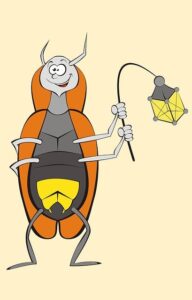
Greetings, readers. Today we learn about freaky fireflies as we continue our series, Caring for Mother Nature, by my friend, author and naturalist, Peggy Sias Lantz (click her name to visit her website).
Fireflies
by Peggy Lantz
The last time I visited my brother in Clemson, South Carolina, was firefly season. I enjoyed going outside and sitting on his small porch as dusk closed in. I listened as the birds settled down in their roosts for the night, chittering and rustling among the leaves.
Then an insect began a low buzzing and was immediately joined by another, and then the chorus of hundreds tuned up and buzzed and clicked and hummed in the dark.
Then the fireflies came out of their hiding places. I sat there mesmerized as the firefly flashes sparked all around me and the insect chorus sang, and the darkness deepened.
Fireflies are not flies
Fireflies, also called lightning bugs, are neither flies nor bugs. They are beetles. (A beetle is identified by its hard exoskeleton and two pairs of wings, a hard outer wing that protects the soft under wing that is used for flying.)
Florida has 57 species of fireflies. Seventeen of them are endemic to Florida. Their flashes are under their tails and are mating signals, which come in different colors of green, orange, and white, and flash at different intervals and different speeds. Some species flash every second or faster, while some flash only three times in ten seconds. In some species only the female flashes to attract a male; in other species, both male and female flash. Each flash sequence and color is unique to its species and attracts a mate of its own species.
What’s the firefly’s light?
The light is called bioluminescence. It is a chemical reaction that produces no heat. Other insects also display bioluminescence, such as glowworms (Remember the song?) and click beetles. If you boat on the Indian River some nights, the water is alive with bioluminescence.
Some species of fireflies like swampy habitats, others dry or forested. Fireflies go through total metamorphosis, from egg to larva to adult beetle. The larvae have hard flat bodies and also glow, for some unknown reason (maybe just practicing), and eat small insects, snails, and worms.
Fireflies are no longer as common as they once were. I remember as a child in Miami catching a bottle full of fireflies in my yard. Their habitats have been paved, lack the fire they are dependent upon, the plants they need have been replaced by lawns and plants from other countries, and insecticides are over-used.
When fireflies fly
Fireflies are out in the evening at Oakland Nature Preserve now [in November, in Florida]. Jennifer Hunt, the director, says they usually are out in the spring, which is when she announces firefly walks, and she doesn’t know why they are appearing in November. There was a firefly specialist at the University of Florida, but unfortunately, he died, so we’re on our own speculating on the phenomenon of November fireflies. But you might enjoy an evening walk at the Preserve soon.
—END—
Thanks for reading!
Your writer on the wing,
Charlene







